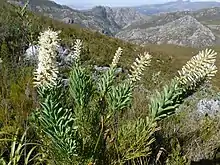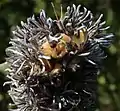| Paranomus sceptrum-gustavianus | |
|---|---|
 | |
| Scientific classification | |
| Kingdom: | Plantae |
| Clade: | Tracheophytes |
| Clade: | Angiosperms |
| Clade: | Eudicots |
| Order: | Proteales |
| Family: | Proteaceae |
| Genus: | Paranomus |
| Species: | P. sceptrum-gustavianus |
| Binomial name | |
| Paranomus sceptrum-gustavianus (Sparrm.) Hyl. | |
| Synonyms[2] | |
| |
Paranomus sceptrum-gustavianus, the King Gustav's sceptre, is a flowering shrub that belongs to the genus Paranomus and forms part of the fynbos. The plant is native to the Western Cape, South Africa.
Description
The shrub grows to 1.8 m (5.9 ft) tall. The lower leaves of the shrub are finely divided and the upper one is spoon-shaped or diamond-shaped. The flowers are clustered in small heads, 16–22 mm (0.63–0.87 in) long and in cylindrical veins. The shrub blooms from July to March. Fire destroys the plant but the seeds survive. The plant is bisexual and pollination takes place through the action of insects. The fruit ripens two months after the plant has flowered and the seeds fall to the ground where they are spread by ants.
Distribution and habitat
The plant occurs from the Hottentots Holland Mountains to the western Langeberg as well as the Elim plains. The plant grows on sandstone slopes at altitudes of 150–500 mm (5.9–19.7 in).
Gallery
References
- ↑ Rebelo, A.G.; Mtshali, H.; Raimondo, D.; von Staden, L.; Helme, N.A. (2020). "Paranomus sceptrum-gustavianus". IUCN Red List of Threatened Species. IUCN. 2020: e.T113202241A185573116. doi:10.2305/IUCN.UK.2020-3.RLTS.T113202241A185573116.en.
- ↑ "Paranomus sceptrum-gustavianus". Plants of the World Online. Royal Botanic Gardens, Kew. Retrieved 27 December 2021.
- "Threatened Species Programme | SANBI Red List of South African Plants". redlist.sanbi.org.
- "Elongate Sceptres". www.proteaatlas.org.za.
- "Paranomus sceptrum-gustavianus (King Gustav's sceptre)". biodiversityexplorer.info.
- "Paranomus sceptrum-gustavianus | PlantZAfrica". pza.sanbi.org.





